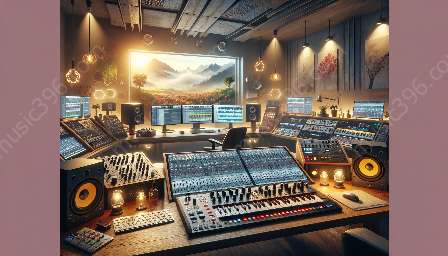Creating a music album involves a multitude of steps, and mixing and mastering are critical processes that shape the final sound. In this comprehensive guide, we will delve into advanced techniques for mixing and mastering music albums, with a focus on analysis of album production. Additionally, we will explore the compatibility of these techniques with CD and audio formats, aiming to provide valuable insights and tips for achieving professional sound quality and optimizing audio levels.
Mixing Techniques
Mixing is a crucial phase in music production, involving the blending of individual tracks to create a cohesive and balanced sound. It encompasses a wide range of technical and creative decisions that significantly impact the overall sonic quality of the album. Below are some advanced mixing techniques that can enhance the final music album:
- Level Balancing: Achieving the right balance of individual track levels is essential for a well-mixed album. Using visual and auditory cues, a mix engineer ensures that no instrument or vocal overpowers the others, creating a harmonious blend of sounds.
- Equalization (EQ): EQ is used to sculpt the frequency content of each track, allowing for tonal adjustments and correction of any frequency imbalances. Parametric and graphic EQs are commonly employed to shape the sound and create a natural, well-defined sonic landscape.
- Dynamic Range Control: Utilizing compressors, limiters, and expanders to control the dynamics of individual tracks and the overall mix is crucial for achieving a consistent and punchy sound. Advanced techniques such as multi-band compression and parallel compression can further refine the dynamic range of the album.
- Spatial Processing: Creating spatial depth and width in the mix through techniques such as panning, stereo enhancement, and reverberation can add dimension and immersion to the music, enhancing the listening experience.
By employing these advanced mixing techniques, a mix engineer can elevate the sonic character of the album, ensuring that each element complements the others and contributes to a cohesive, engaging listening experience.
Mastering Techniques
Once the mixing process is complete, the mastered stage refines the overall sound and prepares the music for distribution and consumption across various formats, including CD and audio streaming platforms. Advanced mastering techniques play a crucial role in ensuring that the album achieves a competitive and professional standard. Some key mastering techniques include:
- Dynamic Processing: Utilizing multi-band compression, dynamic EQ, and saturation to impart a cohesive and balanced dynamic profile to the music, ensuring that it translates well across different playback systems.
- Equalization and Harmonic Enhancement: Fine-tuning the tonal balance and enhancing the harmonic richness of the music through precision EQ adjustments, harmonic exciters, and stereo widening techniques to achieve a polished and impactful sound.
- Loudness Optimization: Applying level normalization and loudness maximization techniques to ensure that the album maintains a competitive loudness level while preserving dynamic contrasts and preventing excessive clipping or distortion.
- Sequencing and Fades: Arranging the track order and applying appropriate fade-ins and fade-outs to ensure a seamless and coherent listening experience, especially for physical media such as CDs where track transitions play a significant role.
These advanced mastering techniques serve to unify the sonic characteristics of the album, adding the final touches to the audio and preparing it for distribution on CDs and various audio formats.
Analysis of Album Production
As an integral part of the music production process, the analysis of album production involves critically evaluating the technical and artistic aspects of the album, aiming to uncover areas of improvement and refinement. In the context of mixing and mastering, conducting a thorough analysis of album production can provide valuable insights into the effectiveness of the employed techniques and their impact on the overall sound quality.
Key elements of album production analysis related to mixing and mastering include:
- Tonal Balance and Frequency Distribution: Assessing the tonal balance across the album and the distribution of frequencies to ensure that the mix and master accurately capture the intended sonic character and emotive qualities of the music.
- Dynamic Range and Loudness Consistency: Analyzing the dynamic range and loudness consistency of the album to identify any potential issues related to excessive compression, limited dynamics, or inconsistencies in loudness levels between tracks.
- Spatial Imaging and Depth Perception: Evaluating the spatial imaging and depth perception within the music to determine the effectiveness of spatial processing techniques employed during mixing and mastering, ensuring a captivating and immersive listening experience.
- Translatability Across Formats: Assessing how the mixed and mastered album translates across various formats, particularly focusing on the compatibility with CD and audio playback systems to ensure optimal sonic representation.
By conducting a detailed analysis of album production, producers and engineers can gain deeper insights into the strengths and weaknesses of the mixing and mastering processes, paving the way for continuous improvement and refinement of their craft.
CD and Audio Compatibility
When addressing mixing and mastering techniques for music albums, it is essential to consider the compatibility of the final product with CD and audio formats, as these remain prevalent mediums for music consumption and distribution. Achieving optimal compatibility with CD and audio playback systems involves meticulous attention to technical specifications and sonic characteristics, ensuring that the album translates seamlessly to these formats. Some considerations for CD and audio compatibility include:
- Red Book Standards: Adhering to the technical specifications outlined in the Red Book standard for audio CDs, including sample rate, bit depth, and file format, to ensure the album is compliant and can be accurately replicated on CDs.
- Mastering for Different Formats: Tailoring the mastering process to accommodate the sonic characteristics and playback constraints of CD and audio formats, such as addressing potential limitations in frequency response and dynamic range.
- Quality Control and Listening Tests: Engaging in rigorous quality control measures and extensive listening tests to evaluate the album's compatibility with CD and audio playback systems, identifying and rectifying any discrepancies or anomalies in the sonic representation.
- Metadata and CD-Text: Ensuring accurate metadata and CD-Text information is embedded in the final master, providing essential details about the album and tracks when played on CD and audio players.
By prioritizing compatibility with CD and audio formats during the mixing and mastering stages, music professionals can guarantee that the album maintains its sonic integrity and accurately reflects the artists' intentions across various listening environments and playback systems.
Conclusion
In conclusion, mastering the art of advanced mixing and mastering techniques for music albums involves a combination of technical expertise, creative intuition, and meticulous attention to detail. By incorporating advanced mixing techniques to blend individual tracks seamlessly and employing mastering techniques to refine and optimize the overall sound, producers and engineers can elevate the sonic quality of the album to professional standards. The analysis of album production serves as a critical tool for assessing the efficacy of these techniques and guiding continuous improvement, while ensuring compatibility with CD and audio formats guarantees a seamless listening experience across different mediums. Ultimately, mastering the intricacies of mixing and mastering contributes to the creation of music albums that resonate with audiences and stand the test of time.






























